Explore Award-Winning Jobs by Popular CDA Architects
Explore Award-Winning Jobs by Popular CDA Architects
Blog Article
The Effect of Technological Developments on the Style Practices of Contemporary Architects
The fast development of technical tools has actually significantly reshaped the style landscape for contemporary designers, promoting unmatched levels of technology and sustainability. Discovering these dynamics exposes a nuanced interaction in between innovation and standard style approaches, motivating a more detailed evaluation of what the future holds for building methods.
Evolution of Architectural Devices
Just how have building devices transformed the layout and building and construction procedures over the centuries? The advancement of architectural devices has considerably impacted the efficiency, precision, and imagination of design and building.
With the advent of the Renaissance, the intro of the compass and the protractor noted a crucial shift. These devices made it possible for architects to attain greater accuracy in their styles, helping with the emergence of more complex and proportionate buildings. The Industrial Change even more reinvented building experiment the intro of mechanical devices and products, permitting for bigger and more enthusiastic projects.
In the 20th century, the development of computer-aided layout (CAD) software application changed the landscape once more, giving engineers with unprecedented capabilities in modeling and visualization. Today, progressed devices such as Building Information Modeling (BIM) and parametric layout software remain to push the borders of building advancement, making it possible for a much more incorporated strategy to design and construction processes.
Boosted Collaboration in Style
As modern technology remains to evolve, enhanced partnership in layout has actually ended up being a foundation of modern-day architectural practice. The integration of digital devices such as Structure Details Modeling (BIM), cloud-based platforms, and advanced visualization software has transformed the means engineers, engineers, and stakeholders connect throughout the style procedure. These tools help with real-time interaction, allowing groups to share concepts, adjustments, and responses promptly, no matter of geographical place.

In addition, interdisciplinary collaboration has actually been streamlined with these technical innovations, making it possible for designers to function extra carefully with various other experts, such as metropolitan planners and environmental consultants. The result is a much more natural approach to create that takes into consideration different perspectives and expertise. Inevitably, improved partnership in layout is not merely a fad; it is vital for developing ingenious, practical, and visually pleasing architecture in an increasingly intricate world.
Sustainability Via Innovation
Sustainability in style has actually significantly come to be intertwined with technical technology, driving the market towards eco liable practices - cda architects. Contemporary architects are leveraging innovative modern technologies to reduce ecological effect while boosting the performance of structures. One famous instance go now is using Structure Info Modeling (BIM), which enables exact planning and resource allocation, reducing waste throughout construction and advertising power effectiveness throughout a structure's lifecycle
Furthermore, smart products and energy-efficient systems are being integrated into designs to maximize source use. Technologies such as photovoltaic or pv cells and environment-friendly roof harness renewable resource sources, adding to decreased carbon impacts. Additionally, the application of synthetic knowledge in style procedures enables engineers to mimic and assess power consumption, guiding decisions towards more sustainable outcomes.
The assimilation of lasting innovations not just aligns with worldwide ecological objectives yet likewise satisfies an enhancing need from customers for environmentally friendly options. As engineers accept these developments, the emphasis shifts in the direction of producing rooms that are not only cosmetically pleasing yet also functionally lasting, consequently redefining the standards of contemporary design. In this method, modern find here technology acts as a stimulant for sustainability, enabling architects to create structures that respect and improve the native environment.
Difficulties in Implementation
While technical advancements in style hold excellent promise for boosting sustainability, their implementation usually experiences considerable challenges - cda architects. One key challenge is the high learning curve connected with new innovations. Engineers and construction experts may need considerable training to efficiently use advanced software program and tools, which can delay job timelines and increase expenses
Additionally, the combination of arising technologies, such as Building Info Modeling (BIM) and sustainable products, commonly requires partnership throughout multidisciplinary teams. This cooperation can be hindered by distinctions in experience, process, and communication designs, bring about prospective conflicts and inadequacies.
Financial constraints even more complicate the fostering of cutting-edge modern technologies. Several architectural companies, specifically smaller sized ones, may lack the sources to purchase sophisticated tools, limiting their ability to take on bigger companies that can pay for such investments.
In addition, regulative frameworks and building regulations may not equal technical innovations, producing obscurity and possible compliance issues. This challenge can inhibit architects from fully welcoming brand-new innovations, as the danger of non-compliance may outweigh the advantages. Addressing these execution difficulties is critical for the successful assimilation of technical developments in contemporary building methods.
Future Patterns in Architecture
The challenges connected with the application of new innovations in architecture have actually prompted a reevaluation of future trends within the industry. As designers navigate issues such as sustainability, urbanization, and social equity, they are significantly taking on cutting-edge technologies to enhance layout performance and environmental efficiency.
One noticeable pattern is the integration of expert system (AI) in the design procedure. AI tools can assess substantial datasets to inform design decisions, improving both creativity and capability. Structure Info Modeling (BIM) continues to develop, making it possible for real-time collaboration among stakeholders and helping with structured job administration.
Lasting design methods are likewise gaining energy, with designers concentrating on adaptive reuse and regenerative layout principles that reduce source intake and waste. The unification of smart materials and renewable resource sources will certainly even more boost the resilience of buildings despite environment modification.

Verdict
Technological innovations have actually considerably reshaped building design practices, helping with enhanced precision, partnership, and sustainability. The integration of tools such as Building Details Modeling and parametric design software program, together with fabricated great post to read intelligence and wise materials, encourages engineers to deal with complicated obstacles a lot more effectively.
Report this page